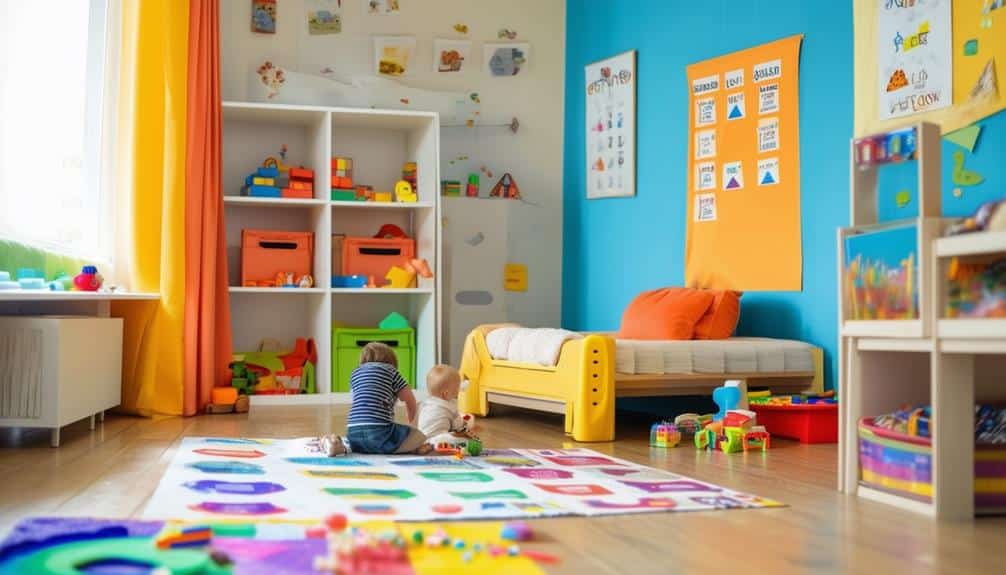Managing autism behaviors in children is challenging for parents, educators, and caregivers. However, with the right strategies, you can handle these challenges and create a nurturing environment for growth. Start by implementing consistent routines and visual supports like timers and First/Then boards. These tools help children understand what comes next, reducing anxiety. Creating sensory-friendly environments using noise-canceling headphones or weighted blankets makes a big difference. Structured learning activities that break tasks into smaller steps can help kids succeed.
You can also encourage independence and social skills through role-playing and group activities. Collaborating with professionals for personalized behavior management strategies, including DIR/Floortime, is essential. To manage autism behaviors effectively, positive reinforcement and clear communication are necessary. By using these techniques, you can build a supportive and understanding environment. This approach helps autistic children feel more comfortable and confident, leading to better behavior and overall development.
Key Takeaways
- Implement visual supports such as timers and First/Then boards to aid in task completion and time management.
- Establish clear expectations and consistent routines to foster predictability and reduce anxiety.
- Encourage independence and social skills development through role-playing and group activities.
- Create sensory-friendly environments using tools like noise-canceling headphones and weighted blankets to minimize sensory triggers.
- Collaborate with professionals for personalized behavior management strategies, including ABA therapy.
Understanding Autism and Behavioral Changes
Exploring the intricate world of autism requires a thorough comprehension of the behavioral changes it encompasses and how these can be effectively managed to foster positive growth in autistic children. Characterized by challenges in language comprehension, sensory processing, routine adherence, and engaging in open-ended activities, autism is a complex condition that necessitates adaptive and empathetic strategies for managing behavioral changes.
A proactive approach to preventing problem behaviors and promoting positive actions is essential in managing these changes. This strategy requires a deep understanding of autism characteristics and the implementation of effective behavior management strategies. These include clear communication, visual support, consistent expectations, and positive reinforcement. Adapting these strategies according to specific needs is essential while acknowledging good behavior and allowing children to earn privileges.
Creating sensory-friendly environments is critical to managing behavioral challenges. These environments engender a sense of comfort and ease, reducing stress and encouraging more constructive behavior. Another vital aspect is promoting social skills development. Collaboration with professionals can help children build these skills, improving their ability to interact, engage, and communicate effectively. Understanding autism and managing behavioral changes are crucial to nurturing positive growth in autistic children.
Implementing Visual Support Techniques
Understanding the specific needs of children with autism is vital in effectively managing their behavioral challenges. An essential aspect of this understanding is recognizing the benefits visual supports, such as visual timers and first/then boards, bring to these children. These techniques offer tangible ways to enhance comprehension, reduce anxiety, and promote independence, acting as essential aids in their daily routines.
Utilizing Visual Timers
Children with autism often grapple with managing their time efficiently, a challenge that visual timers such as the Red Clock Visual Timer can effectively mitigate. These visual aids offer a concrete representation of time, which is essential for autistic children who may struggle with abstract concepts.
Visual timers enhance time management skills by allowing children to understand the passage of time visually. This tool is also instrumental in anxiety reduction. By providing a clear visual cue, autistic children can anticipate changes between activities, reducing anxiety associated with unexpected changes.
Visual timers are not a one-size-fits-all solution. It is essential to select a timer that caters to specific needs. Several free visual timer apps offer adaptable options, allowing for a tailored approach to managing time for autistic children.
| Visual Timer | Advantages | Illustrations |
|---|---|---|
| Red Clock Visual Timer | Improve Time Management | Physical Timer |
| Sand Timers | Alleviate Anxiety | Tangible Timer |
| Free Timer Apps | Address Specific Needs | Digital Timer |
Developing First/Then Boards
An invaluable tool in managing behavioral challenges in autistic children, First/Then boards offer a tangible, visual method to communicate tasks in sequence, enhancing understanding and expectation management for these children. Developed as visual supports, these boards provide a concrete representation of what will happen first, followed by what will happen next, thereby increasing task completion and expectation clarity.
Employing First/Then boards can lessen anxiety in autistic children, offering a supportive framework that encourages task comprehension. This tool can be tailored based on the child’s references, using either images or written words, making it versatile and adaptable to individual needs.
The primary strength of First/Then boards is their ability to visually express intricate sequences of activities, simplifying them into manageable steps. This can lead to a notable reduction in behavioral challenges as children become more confident in understanding what is expected of them. Providing a predictable structure, first/then boards can help children feel secure, improve their overall behavior, and encourage positive task engagement. This visual support technique, when used consistently, can be an effective way to manage and cope with the behavioral challenges that often arise in autistic children.
Establishing Clear Expectations

In the world of autism, clarity in expectations serves as a beacon of structure, reducing anxiety and fostering predictability for the child. Clear expectations are not just guidelines; they are a roadmap for autistic kids to understand what is expected of them, and this understanding is a vital pillar of behavior management.
Establishing clear expectations provides a framework that imbues the child with routine and consistency. This predictability can significantly reduce anxiety, as the child knows what to expect and what is expected of them. It eliminates the ambiguity that often causes distress and confusion in autistic kids.
Moreover, these expectations are not merely about correction but aim to promote positive behavior. When children know the expectations, they are more likely to meet them, reinforcing positive behavior patterns. It’s not just about managing behavior but nurturing it.
Encouraging Independence and Social Skills
While managing behavioral challenges, the cultivation of independence and social skills in autistic children cannot be overlooked, as these are integral to their overall development and well-being. Encouraging independence can be fostered by promoting self-help skills and providing opportunities for decision-making. This imparts a sense of autonomy and cultivates self-regulation, thereby building confidence and social competence.
Various strategies can help autistic children build social skills. For instance, role-playing can help them rehearse authentic social scenarios, and practicing turn-taking can enhance their understanding of reciprocal social interactions. Engaging autistic children in group activities and using social stories can further augment these skills. Under the empathetic and knowledgeable guidance of caregivers and educators, autistic children can navigate social situations more effectively.
It is essential to celebrate even the most minor achievements of autistic children in their journey towards independence and positive social interactions. This boosts their morale and fosters a willingness to continue learning. By maintaining patience and using these proven techniques, we can help autistic children manage behavioral challenges while advancing their independence and social skills.
Creating Sensory-Friendly Environments

Creating sensory-friendly environments is essential to managing behavioral challenges in autistic children. Minimizing sensory triggers and implementing sensory tools can create calming spaces that significantly reduce overstimulation and encourage focus. This approach, which respects each child’s individual sensory preferences, has been shown to enhance the overall well-being and mental stability of children on the autism spectrum.
Minimizing Sensory Triggers
Managing sensory triggers effectively can significantly enhance the comfort and well-being of children with autism. This necessitates creating quiet spaces, providing sensory tools like noise-canceling headphones, and giving visual aids to help these children cope with sensory overload. Such strategies are instrumental in respecting their sensory preferences and mitigating their sensory challenges.
A sensory-friendly space tailored to individual needs can significantly minimize sensory triggers. This may involve dimming lights, adjusting noise levels, moderating temperature, and choosing textures that align with the comfort. Calming scents or weighted blankets can provide sensory support and soothing environmental elements.
Addressing sensory needs also incorporates sensory breaks, fidget tools, and visual schedules into the routine. These interventions support individuals with autism in managing their sensory challenges. By acknowledging and respecting their sensory preferences, we can create an environment that fosters their growth while minimizing the overstimulation that often accompanies autism. This empathetic and knowledgeable approach is a cornerstone in managing behavioral challenges in those with autism. Ensuring the comfort and well-being of these children is not just an obligation but a commitment to serving others with compassion and understanding.
Implementing Sensory Tools
In the quest to create a supportive environment for children with autism, implementing sensory tools becomes a pivotal strategy, aiding in regulating sensory input and reducing overstimulation. Sensory tools such as fidget toys, noise-canceling headphones, and calming blankets can provide comfort and serve as anchors in creating sensory-friendly environments.
Minimizing sensory triggers is a critical component of these environments. For children with noise sensitivity, headphones can help filter out unnecessary auditory input, creating a calming atmosphere. Respecting the sensory preferences of each child is paramount, as what soothes one child may distress another.
Sensory tools do more than reduce overstimulation; they can also support the regulation of feelings. By helping children manage their sensory input, these tools mitigate the risk of outbursts and reduce challenging behaviors.
To serve our children best, we must understand and empathize with their sensory needs. Implementing sensory tools and creating sensory-friendly environments is a knowledgeable and proven strategy to manage behavioral challenges in autistic children effectively. This approach helps children feel more comfortable and empowers them to regulate their feelings and responses more effectively.
Adopting Structured Learning Activities
Adopting structured learning strategies, which involve breaking tasks into manageable steps, presents an essential approach to enhance understanding and task completion for children with autism. When combined with visual schedules, these strategies set clear expectations and provide a consistent routine that can significantly reduce anxiety and promote positive behavior.
Incorporating visual aids and tailoring the strategies to personal interests can significantly improve engagement, making learning a more enjoyable and rewarding experience for the child. For instance, if a child is fascinated with trains, a counting activity could involve placing the correct number of passengers onto a toy train. This approach makes the learning process more appealing and leverages the child’s existing knowledge and enthusiasm, enhancing their comprehension and retention.
Moreover, providing breaks as needed during these structured strategies helps prevent overwhelm and supports emotional regulation. This thoughtful consideration fosters a more patient and resilient attitude toward learning, significantly contributing to their overall development and well-being. It is a testament to how adopting structured learning strategies can be a powerful tool in managing behavioral challenges in autistic children.
Collaborating With Professional Support

Exploring the intricacies of autism can often be challenging. Hence, professional support, such as behavior therapists and psychologists, is invaluable, as it provides tailored strategies and valuable insights into managing behavioral challenges. Pediatric occupational therapists, with their expert training in the principles of behavior for children with autism, can be instrumental in developing personalized behavior management strategies.
Moreover, these professionals can assess and address the child’s sensory needs, helping them manage over-stimulation, which often exacerbates behavioral issues. They also offer resources and tools to foster positive behaviors and enhance communication skills. Collaborating with professional support empowers caregivers with the knowledge and skills necessary to navigate this complex journey, promoting the child’s overall well-being.
Applying Behavior Management Strategies
Exploring the terrain of autism, it becomes evident that applying behavior management strategies, such as visual supports, structured teaching techniques, and positive reinforcement, is a cornerstone in effectively addressing the specific needs of autistic children. These Behavior Strategies provide these children clarity, predictability, and a sense of control, enhancing their ability to navigate their environment.
| Behavior Strategies | Description | Example |
|---|---|---|
| Visual Schedule | Utilizes graphics to represent daily activities, reducing anxiety and improving understanding. | A chart illustrating a child’s routine. |
| Communication Strategies | It aims to enhance interaction, expression, and comprehension. | Teaching sign language or the use of electronic communication aids. |
Positive Reinforcement encourages the repetition of positive behaviors by rewarding desired actions. For Example, a child may be given a favorite toy after completing a task.
Individualized plans tailored to each child’s needs are essential. They incorporate distinct sensory input preferences and promote positive behaviors, thus fostering a conducive learning environment. Early intervention is critical, as it can significantly improve the child’s development. Collaborating with caregivers and professionals ensures the consistent application of these strategies, maximizing their impact. Carefully applied, these techniques can help children with autism lead fulfilling lives.
Supporting Transitions and Sensory Needs

Often, children with autism face challenges during changes and exhibit unique sensory needs; as a result, implementing supportive measures can significantly alleviate their anxiety and enhance their understanding of dynamic environments. Empowering these children with limited alternatives during shifts can dramatically reduce their stress. For example, allowing the child to choose between two activities can give them a sense of control, easing the change.
Visual cues also play a crucial role in assisting children with changes. Displaying upcoming tasks or activities visually helps prepare the child for adjustments, making the process less overwhelming. Integrating visual schedules into the child’s daily routine is another effective strategy. These schedules provide a clear roadmap of what to anticipate, thereby reducing uncertainty and anxiety.
Creating sensory-friendly environments is vital to address the sensory needs of autistic children. It involves minimizing sensory triggers and providing tools that support children with sensory sensitivities. Lastly, tools like first/then boards visually represent tasks and help provide clear instructions. This approach facilitates smooth adjustments, ultimately contributing to a more positive and comfortable experience for autistic children.
Frequently Asked Questions
How to Manage the Autism Behaviors in Children?
Managing behavioral problems in autistic children involves tailored strategies such as Behavior Intervention Plans, Applied Behavior Analysis, early intervention, visual supports, and structured teaching in collaboration with professionals and caregivers.
What Coping Strategies Can Individuals With Autism Use to Manage Their Behaviour?
Like a compass guiding a ship, coping strategies such as deep breathing, sensory tools, and visual schedules can steer autistic individuals toward effective behavioral management. Calming techniques and structured routines can further support this journey.
How Do You Control an Autistic Child’s Behavior?
Visual supports, positive reinforcement techniques, and structured routines should be implemented to control an autistic child’s behavior. Seek professional assistance for tailored strategies. Consistency in expectations, choices, and visual cues can effectively manage the child’s behavior.
What Is the Behavioral Technique for Autism?
Behavioral techniques for autism are like navigational tools, guiding autistic children through their distinct challenges. These evidence-based strategies, including DIR/Floortime, focus on understanding behavior triggers and implementing positive reinforcement for effective management.


Recent Comments